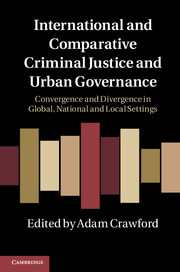 International and Comparative Criminal Justice and Urban Governance
International and Comparative Criminal Justice and Urban Governance from PART 3 - Comparative crime control and urban governance
Published online by Cambridge University Press: 05 June 2011
Introduction
This chapter is concerned with crime prevention as part of a broader picture of urban governance. It focuses on residential areas in the UK and specifically on gated developments, a relatively new but fast-proliferating form of housing frequently cited as an exemplar of the current era's ‘fortress mentality’ (see Blakely and Snyder 1997; McKenzie 1994; and special issues of Environment and Planning B 2002 29: 3, GeoJournal 2006 66: 1–2, and Housing Studies 2005 20: 2). Academic debate has tended to concentrate on analysing the driving forces for gated communities as a particular urban form and on the implications of their recent growth for social exclusion and social cohesion, with less emphasis on whether gated communities are effective in preventing crime or merely cause displacement. The term ‘gated community’ is usually understood as a form of private residential neighbourhood defined by a physical boundary, as well as by a legal framework which relates only to that neighbourhood and which binds the residents contractually through their property rights (Atkinson et al. 2003).
Here it is argued that boundaries and enclosures of all kinds are now established as a key technique of governance in late modernity, the period from the latter half of the twentieth century to the present (Garland 2001). Walls are a visible sign of the current obsession with boundaries, and can be seen at many scales: the fortified border between Mexico and the USA, the West Bank wall, guarded refugee camps and gated communities.
To save this book to your Kindle, first ensure [email protected] is added to your Approved Personal Document E-mail List under your Personal Document Settings on the Manage Your Content and Devices page of your Amazon account. Then enter the ‘name’ part of your Kindle email address below. Find out more about saving to your Kindle.
Note you can select to save to either the @free.kindle.com or @kindle.com variations. ‘@free.kindle.com’ emails are free but can only be saved to your device when it is connected to wi-fi. ‘@kindle.com’ emails can be delivered even when you are not connected to wi-fi, but note that service fees apply.
Find out more about the Kindle Personal Document Service.
To save content items to your account, please confirm that you agree to abide by our usage policies. If this is the first time you use this feature, you will be asked to authorise Cambridge Core to connect with your account. Find out more about saving content to Dropbox.
To save content items to your account, please confirm that you agree to abide by our usage policies. If this is the first time you use this feature, you will be asked to authorise Cambridge Core to connect with your account. Find out more about saving content to Google Drive.